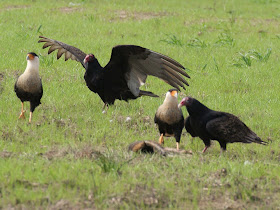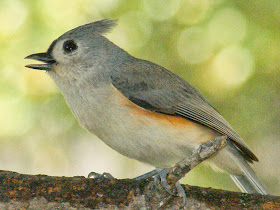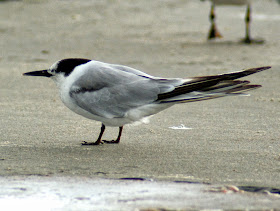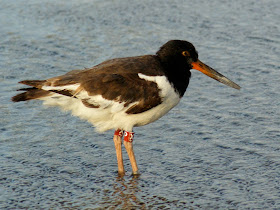.
.
Jeff Mohamed blogs about birds and other wildlife in the Houston area - and occasionally farther afield.
Wednesday, October 30, 2013
Monday, October 28, 2013
San Jacinto
.
Saturday morning we drove over to the San Jacinto Monument site on our way to Baytown Nature Center.
The boardwalk had several Sedge Wrens, as well as a Tricolored Heron (below).
The bare trees in and around the bay were crowded with Neotropic Cormorants, drying their wings or simply resting.
The bay itself was busy with hundreds of American White Pelicans.
Lines of Pelicans were crisscrossing the water.
Brown Pelicans fish by diving headfirst into the water. White Pelicans fish by floating on the surface and dipping their heads into the water. They often fish in groups, forming a semi-circle or complete circle in order to corral their prey.
After watching the pelicans for a while, we headed to Baytown via the Lynchburg ferry. Before taking the ferry, we stopped to check out the beach below the Monument Inn. I was hoping for a range of shorebirds but the only birds there were American Avocets (below) and Laughing Gulls.
.
Saturday morning we drove over to the San Jacinto Monument site on our way to Baytown Nature Center.
The boardwalk had several Sedge Wrens, as well as a Tricolored Heron (below).
The bare trees in and around the bay were crowded with Neotropic Cormorants, drying their wings or simply resting.
The bay itself was busy with hundreds of American White Pelicans.
Lines of Pelicans were crisscrossing the water.
Brown Pelicans fish by diving headfirst into the water. White Pelicans fish by floating on the surface and dipping their heads into the water. They often fish in groups, forming a semi-circle or complete circle in order to corral their prey.
After watching the pelicans for a while, we headed to Baytown via the Lynchburg ferry. Before taking the ferry, we stopped to check out the beach below the Monument Inn. I was hoping for a range of shorebirds but the only birds there were American Avocets (below) and Laughing Gulls.
.
Friday, October 25, 2013
Eagles and Vultures
.
Non-birder friends and acquaintances are often excited to tell me that they've just seen an eagle. However, when I question them about their sighting, it usually turns out that what they saw was not an eagle but one of three other species of large birds that are resident in our area.
It seems that the bird most often misidentified as an eagle is the Turkey Vulture, a huge bird that is common throughout the USA. Turkey Vultures don't have the most beautiful faces but they fly like angels, using air currents so well that they only rarely have to flap their wings.
Here in the Houston area we are lucky to have two species of resident vultures. The second is the Black Vulture, a bird whose range is largely restricted to the southern and southeastern states. The Black Vulture has a gray face and neck, and has white only at the tips of its wings. It is smaller than the Turkey Vulture and has to flap its wings much more often as it flies.
BTW, the reason why vultures have such ugly heads and necks is a very practical one: It doesn't make sense to have a beautiful plumage on your head and neck if these parts are going to spend a lot of time rooting around inside the dead bodies of other animals.
Another bird that is frequently mistaken for an eagle is the Crested Caracara, a type of falcon whose US range used to be almost entirely limited to south Texas but which has now extended that range to include much of the eastern half of the state.
Although the Caracara is in the falcon family, it often acts more like a scavenger than a bird of prey. So, as the following pictures show, it may be seen arguing over carcasses with Turkey and Black Vultures.
So don't we have any eagles in our area? Well, yes, we do. Although Golden Eagles are pretty rare in this part of Texas, we certainly get quite a lot of Bald Eagles.
Many of these magnificent birds just migrate through our area but some spend most of the year and even nest here. One pair regularly nests in Baytown. The picture below is from last year and shows a parent with one of two chicks raised.
This spring I was surprised to find another pair nesting not a mile from our house in Cypress, northwest of Houston. I wasn't able to get good photos of these birds on the nest but I did get some shots of their juvenile shortly before the birds left the nesting site in the early summer.
.
Non-birder friends and acquaintances are often excited to tell me that they've just seen an eagle. However, when I question them about their sighting, it usually turns out that what they saw was not an eagle but one of three other species of large birds that are resident in our area.
It seems that the bird most often misidentified as an eagle is the Turkey Vulture, a huge bird that is common throughout the USA. Turkey Vultures don't have the most beautiful faces but they fly like angels, using air currents so well that they only rarely have to flap their wings.
Here in the Houston area we are lucky to have two species of resident vultures. The second is the Black Vulture, a bird whose range is largely restricted to the southern and southeastern states. The Black Vulture has a gray face and neck, and has white only at the tips of its wings. It is smaller than the Turkey Vulture and has to flap its wings much more often as it flies.
BTW, the reason why vultures have such ugly heads and necks is a very practical one: It doesn't make sense to have a beautiful plumage on your head and neck if these parts are going to spend a lot of time rooting around inside the dead bodies of other animals.
Another bird that is frequently mistaken for an eagle is the Crested Caracara, a type of falcon whose US range used to be almost entirely limited to south Texas but which has now extended that range to include much of the eastern half of the state.
Although the Caracara is in the falcon family, it often acts more like a scavenger than a bird of prey. So, as the following pictures show, it may be seen arguing over carcasses with Turkey and Black Vultures.
So don't we have any eagles in our area? Well, yes, we do. Although Golden Eagles are pretty rare in this part of Texas, we certainly get quite a lot of Bald Eagles.
Many of these magnificent birds just migrate through our area but some spend most of the year and even nest here. One pair regularly nests in Baytown. The picture below is from last year and shows a parent with one of two chicks raised.
This spring I was surprised to find another pair nesting not a mile from our house in Cypress, northwest of Houston. I wasn't able to get good photos of these birds on the nest but I did get some shots of their juvenile shortly before the birds left the nesting site in the early summer.
.
Tuesday, October 22, 2013
It's That Time Again
.
On a quick visit to the college nature trail on Thursday, I was pleased to catch sight of a couple of migrants. The first was a Blue-gray Gnatcatcher.
The other bird was a Ruby-crowned Kinglet.
Seeing the Kinglet made me realize that it's about time for our winter yardbirds to start taking up residence. The first to arrive are normally Ruby-crowned Kinglets and Orange-crowned Warblers, both of which tend to turn up in late October.
When I got home from work on Friday, my wife informed me that she'd just seen a Ruby-crowned Kinglet and an Orange-crowned Warbler in our yards. Over the weekend I kept an eye our for both birds but only saw the Warbler. Of course, I don't actually know if it was the same bird that Dee saw because we normally get several Orange-crowned Warblers in our yards each winter - and they all look very much the same to me.
I'm hoping that I get to see the Ruby-crowned soon. And I'm hoping that it's the same male that I believe has spent the past five winters with us. Admittedly, it's difficult to be certain that we've had the same bird each year but it hangs out in exactly the same parts of our yard every year and raises his red crest very frequently, which is not very common behavior.
.
On a quick visit to the college nature trail on Thursday, I was pleased to catch sight of a couple of migrants. The first was a Blue-gray Gnatcatcher.
The other bird was a Ruby-crowned Kinglet.
Seeing the Kinglet made me realize that it's about time for our winter yardbirds to start taking up residence. The first to arrive are normally Ruby-crowned Kinglets and Orange-crowned Warblers, both of which tend to turn up in late October.
When I got home from work on Friday, my wife informed me that she'd just seen a Ruby-crowned Kinglet and an Orange-crowned Warbler in our yards. Over the weekend I kept an eye our for both birds but only saw the Warbler. Of course, I don't actually know if it was the same bird that Dee saw because we normally get several Orange-crowned Warblers in our yards each winter - and they all look very much the same to me.
I'm hoping that I get to see the Ruby-crowned soon. And I'm hoping that it's the same male that I believe has spent the past five winters with us. Admittedly, it's difficult to be certain that we've had the same bird each year but it hangs out in exactly the same parts of our yard every year and raises his red crest very frequently, which is not very common behavior.
.
Friday, October 18, 2013
Blue Jays
.
Dee and I are fond of Blue Jays. We like to watch them as they collect acorns from our lawn or, as here, they collect peanuts that we put out on our backyard fence.
They're fun, too, when they stretch out on the fence in the summer heat.
Mark Twain must have enjoyed watching Blue Jays also, or else he couldn't have written about them with such insight in his story "What Stumped the Bluejays".
"There's more to a bluejay than any other creature. He has got more moods, and more different kinds of feelings than other creatures; and mind you, whatever a bluejay feels, he can put into language. And no mere commonplace language, either, but rattling, out-and-out book talk - and bristling with metaphor, too - just bristling! And as for command of language - why you never see a bluejay stuck for a word. No man ever did. They just boil out of him! And another thing: I've noticed a good deal, and there's no bird, or cow, or anything that uses as good grammar as a bluejay. You may say a cat uses good grammar. Well, a cat does - but you let a cat get excited once; you let a cat get to pulling fur with another cat on a shed, nights, and you'll hear grammar that will give you the lockjaw. Ignorant people think it's the noise which fighting cats make that is so aggravating, but it ain't so; it's the sickening grammar they use. Now I've never heard a jay use bad grammar but very seldom; and when they do, they're as ashamed as a human; they shut right down and leave.
You may call a jay a bird. Well, so he is, in a measure - because he's got feathers on him, and don't belong to no church, perhaps; but otherwise he is just as much a human as you be. And I'll tell you for why. A jay's gifts, and instincts, and feelings, and interests, cover the whole ground.A jay hasn't got any more principle than a congressman. A jay will lie, a jay will steal, a jay will deceive, a jay will betray; and four times out of five, a jay will go back on his solemnest promise. The sacredness of an obligation is a thing which you can't cram into no bluejay's head. Now, on top of all this, there's another thing; a jay can outswear any gentleman in the mines. You think a cat can swear. Well, a cat can; but you give a bluejay a subject that calls for his reserve powers, and where is your cat! Don't talk to me - I know too much about this thing. And there's yet another thing; in the one little particular of scolding- just good, clean, out-and-out scolding - a bluejay can lay over anything, human or divine. Yes, sir, a jay is everything that a man is. A jay can cry, a jay can laugh, a jay can feel shame, a jay can reason and plan and discuss, a jay likes gossip and scandal, a jay has got a sense of humor, a jay knows when he is an ass just as well as you do - maybe better. If a jay ain't human, he better take in his sign, that's all."
Dee and I are fond of Blue Jays. We like to watch them as they collect acorns from our lawn or, as here, they collect peanuts that we put out on our backyard fence.
They're fun, too, when they stretch out on the fence in the summer heat.
Mark Twain must have enjoyed watching Blue Jays also, or else he couldn't have written about them with such insight in his story "What Stumped the Bluejays".
"There's more to a bluejay than any other creature. He has got more moods, and more different kinds of feelings than other creatures; and mind you, whatever a bluejay feels, he can put into language. And no mere commonplace language, either, but rattling, out-and-out book talk - and bristling with metaphor, too - just bristling! And as for command of language - why you never see a bluejay stuck for a word. No man ever did. They just boil out of him! And another thing: I've noticed a good deal, and there's no bird, or cow, or anything that uses as good grammar as a bluejay. You may say a cat uses good grammar. Well, a cat does - but you let a cat get excited once; you let a cat get to pulling fur with another cat on a shed, nights, and you'll hear grammar that will give you the lockjaw. Ignorant people think it's the noise which fighting cats make that is so aggravating, but it ain't so; it's the sickening grammar they use. Now I've never heard a jay use bad grammar but very seldom; and when they do, they're as ashamed as a human; they shut right down and leave.
You may call a jay a bird. Well, so he is, in a measure - because he's got feathers on him, and don't belong to no church, perhaps; but otherwise he is just as much a human as you be. And I'll tell you for why. A jay's gifts, and instincts, and feelings, and interests, cover the whole ground.A jay hasn't got any more principle than a congressman. A jay will lie, a jay will steal, a jay will deceive, a jay will betray; and four times out of five, a jay will go back on his solemnest promise. The sacredness of an obligation is a thing which you can't cram into no bluejay's head. Now, on top of all this, there's another thing; a jay can outswear any gentleman in the mines. You think a cat can swear. Well, a cat can; but you give a bluejay a subject that calls for his reserve powers, and where is your cat! Don't talk to me - I know too much about this thing. And there's yet another thing; in the one little particular of scolding- just good, clean, out-and-out scolding - a bluejay can lay over anything, human or divine. Yes, sir, a jay is everything that a man is. A jay can cry, a jay can laugh, a jay can feel shame, a jay can reason and plan and discuss, a jay likes gossip and scandal, a jay has got a sense of humor, a jay knows when he is an ass just as well as you do - maybe better. If a jay ain't human, he better take in his sign, that's all."
.
Monday, October 14, 2013
This Weekend in Our Yards
.
It was a dark and wet weekend here in Cypress, and so we spent most of it at home. This gave me a chance to see which birds are currently visiting our yards. Unfortunately, though, the lack of light made it impossible to get photos of all of our bird visitors.
For the past few weeks several Blue Jays have been occupying our front yard, where they compete with squirrels to see who can collect the most acorns. At present the Jays are definitely winning.
House Sparrows, White-winged Doves, Carolina Wrens, Northern Mockingbirds and Northern Cardinals have also been much in evidence, and Carolina Chickadees (below) are rarely absent from our feeders.
A Red-bellied Woodpecker often swoops in to our peanut feeder, scaring away our loyal pair of Downy Woodpeckers (below). However, the Downys invariably reappear as soon as the larger woodpecker has left.
The Brown-headed Nuthatches which graced us with their presence for the first half of the year are nowhere to be seen, and the Ruby-throated Hummingbirds that argued over our feeders last month also seem to have gone. Luckily, the past couple of weeks have seen the reappearance of one of our favorite species: Tufted Titmice. Two of these lovely little birds have been feasting on our peanuts and I never tire of watching them. I'm hoping that, unlike the nuthatches, they will become permanent residents in our yards.
.
It was a dark and wet weekend here in Cypress, and so we spent most of it at home. This gave me a chance to see which birds are currently visiting our yards. Unfortunately, though, the lack of light made it impossible to get photos of all of our bird visitors.
For the past few weeks several Blue Jays have been occupying our front yard, where they compete with squirrels to see who can collect the most acorns. At present the Jays are definitely winning.
A Red-bellied Woodpecker often swoops in to our peanut feeder, scaring away our loyal pair of Downy Woodpeckers (below). However, the Downys invariably reappear as soon as the larger woodpecker has left.
.
Thursday, October 10, 2013
Texas City Dike
.
Sunday I was up bright and early to drive along the Texas City Dike. It's a great place for watching and photographing birds because the latter are used to vehicles. So groups of gulls, terns and shorebirds will let you park close beside them.
Unfortunately, Sunday morning dawned cloudy, wet and windy morning, hardly the best conditions for photographing wildlife.
The end of the dike had a few shorebirds: Sanderlings, a Black--bellied Plover and a single Willet.
A Magnificent Frigatebird and several Brown Pelicans were fishing and a dolphin was patrolling the waters but all were too far away for photographs.
At other points along the dike groups of Laughing Gulls, Terns and Black Skimmers hunkered down while waves crashed against the shore.
Most of the Terns were Royal Terns, both adults and speckled-backed juveniles.
However, a few Forster's Terns were also present.
I noticed a handful of Sandwich Terns, too, easy to ID because of the yellow tips on their bills.
Black Skimmers looked ungainly with their huge lower mandibles.
One puddle of water on the road held an American Oystercatcher that had been banded.
Nearby a Willet perched rather forlornly on the rocks, a length of fishing line looped around its neck and bill.
My final sighting was of a Great Blue Heron, looking magnificent against the gray-green water.
Sunday I was up bright and early to drive along the Texas City Dike. It's a great place for watching and photographing birds because the latter are used to vehicles. So groups of gulls, terns and shorebirds will let you park close beside them.
Unfortunately, Sunday morning dawned cloudy, wet and windy morning, hardly the best conditions for photographing wildlife.
The end of the dike had a few shorebirds: Sanderlings, a Black--bellied Plover and a single Willet.
A Magnificent Frigatebird and several Brown Pelicans were fishing and a dolphin was patrolling the waters but all were too far away for photographs.
At other points along the dike groups of Laughing Gulls, Terns and Black Skimmers hunkered down while waves crashed against the shore.
Most of the Terns were Royal Terns, both adults and speckled-backed juveniles.
However, a few Forster's Terns were also present.
I noticed a handful of Sandwich Terns, too, easy to ID because of the yellow tips on their bills.
Black Skimmers looked ungainly with their huge lower mandibles.
One puddle of water on the road held an American Oystercatcher that had been banded.
Nearby a Willet perched rather forlornly on the rocks, a length of fishing line looped around its neck and bill.
My final sighting was of a Great Blue Heron, looking magnificent against the gray-green water.
After Texas City Dike we drove back down to Lafitte's Cove on Galveston, hoping that the cold front would have brought in some migrants. However, the woods were even quieter than the previous day and so we decided to cut our trip short and head home.
.


















































